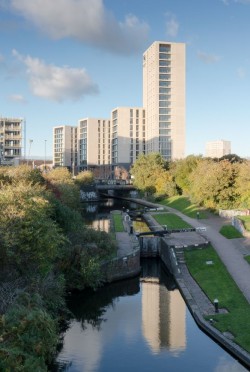With strong government backing for offsite construction methods in the education sector, and numerous operational efficiencies, concrete solutions are perfectly positioned to deliver high performance schools. British Precast’s Matt Butcher talks to precast concrete manufacturers to understand why.
State support for offsite construction methods has never been stronger. Leading the way among public clients is education. The university sector is embracing offsite for faculty buildings and student accommodation, while the Department for Education (DfE) announced the winners of a £3 billion offsite schools framework in January.
In the schools sector, precast concrete undoubtedly scores highly when compared to other offsite construction methods. Robust, with strong acoustic and thermal insulation properties, and quickly assembled on-site, it is little surprise that schools are drawn to concretes many advantages. Fire safety, a particular issue for schools who have to plan for accidental as well as intentional damage such as arson, is an area where precast outperforms its rivals. Concrete offsite construction solutions are classified non-combustible, A1 fire-rated.
Precast concrete manufacturers have experience of supplying school projects. “The use of precast concrete as a material for schools has been increasing over recent years, with the benefits realised by both the client and end-users alike,” says Richard Wilks, Technical Manager at Sterling Services.
Derek Russell, Head of Engineering at Techrete, notes that the nature of schools lend themselves to high levels of repeatability. “A significant advantage of precast concrete in education projects is the economy of design that can be achieved when the modular nature, in terms of classroom layouts, is considered. Exposed concrete also offers a durable and hard-wearing surface. This is a significant benefit in terms of both maintenance costs for internal surfaces and energy efficiency, especially when these are extrapolated over the working life of the structure.”
Acoustic performance – vital in the noisy corridors and classrooms of a school building – also gives precast an edge over other materials. “Due to the durability and density of the concrete used in our façade panels,” adds Richard Wilks. “Excellent noise reduction properties are achieved, important for buildings located near busy main roads with heavy traffic.”
With windows, service channels and finishes invariably taken care of in the factory, site installation of precast panels has become increasingly efficient and quick, says Steve Morgan, Technical Sales Manager for Thorp Precast Limited. “There are no external scaffolding requirements and no wet trades required on-site,” he says. “Safety is increased through reduced numbers on-site, with significantly less site traffic and supervision required. Small teams of specialist erection gangs – typically four men and a crane operator.” With current site operating guidelines due to Covid-19, needing less people on-site this is even more important.
No site storage is required. Panels are lifted from our specially adapted delivery vehicles directly onto the building. It all helps to minimise disruption for schools during construction work. One key advantage of precast and the manufacturing process is the ability to create a high-quality finished surface to both the internal and external faces, subject to the architectural requirements. “All manufacturing is undertaken in factory-controlled conditions and the completed panels can be viewed offsite by the client and design team prior to delivery to site,” adds Steve Morgan.
Within the precasting process it is possible to incorporate bespoke project specific detailing. For example, to replicate coats of arms, crests, school names, patterns and even photographic representations within the finished concrete surface. Concrete offsite solutions are proven to achieve top marks on performance and aesthetics.
For more information visit: www.structuralprecast.org and to download Offsite Concrete Construction guidance visit: www.concretecentre.com/publications
To view the article along with the complete magazine click here









